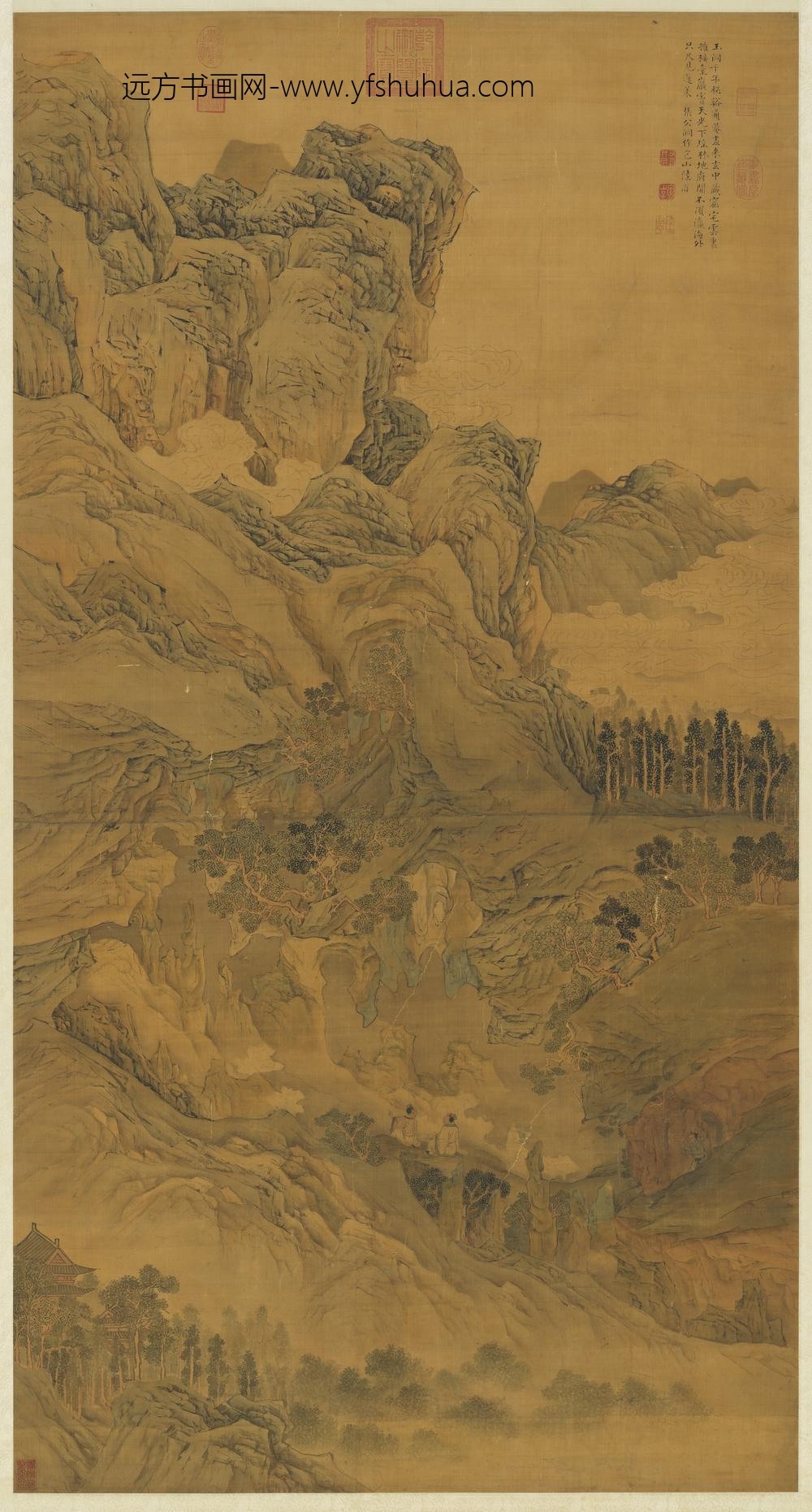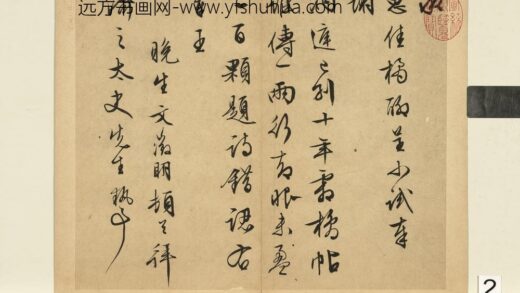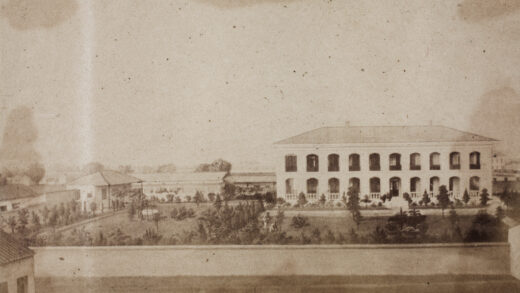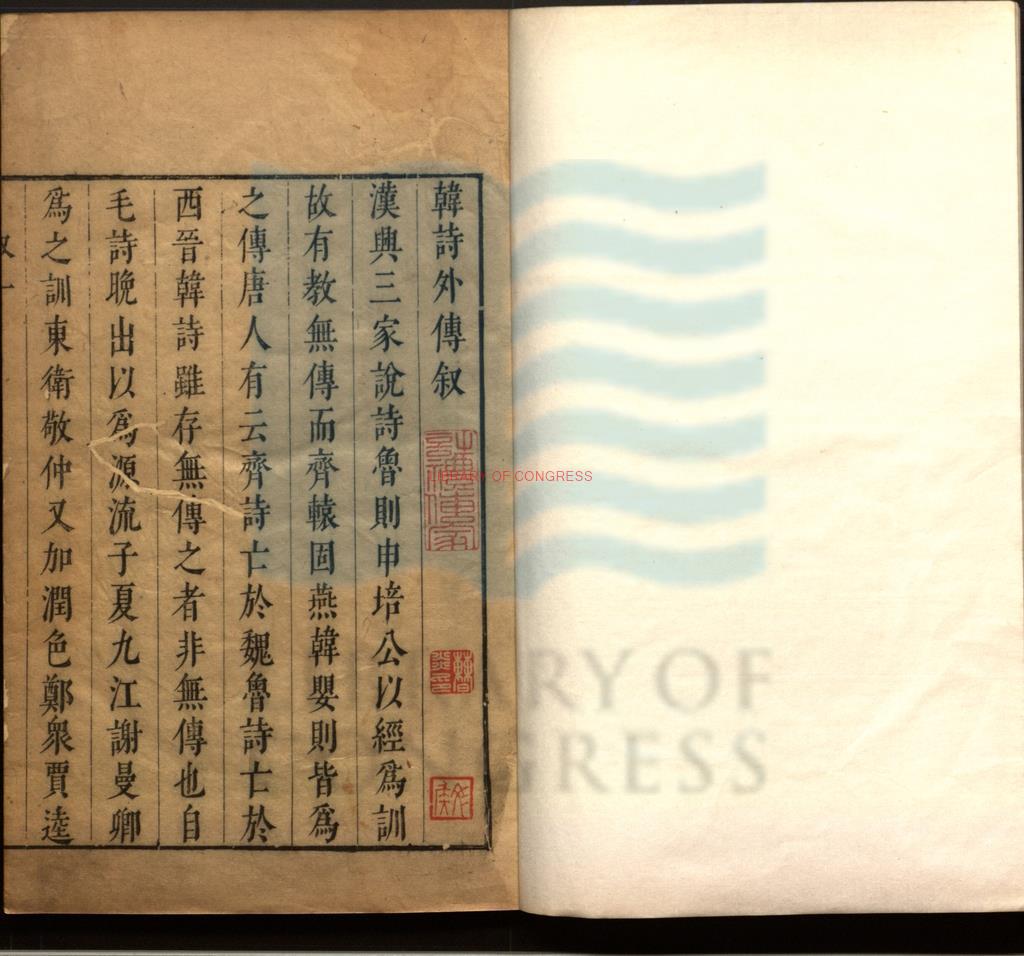【作品基本信息】
| 作者 | 陆治 |
| 品名 | 仙山玉洞图轴 |
| 朝代 | 明代 |
| 文件大小 | 18.03MB |
| 分辨率(DPI) | 300×300 |
| 像素大小 | 1797×3346 |
| 尺寸(CM) | 15.21×28.32 |
| 作品数量 | 1 |
| 作品收藏 | 台北故宫博物院 |
| 图片格式 | 默认提供TIF和JPG两个版本 |
基本数据
| 藏品类型 | 绘画 |
| 品名 |
明陆治仙山玉洞图轴 Jade Grotto in the Mountains of the Immortals |
| 分类 | 绘画 |
| 作者 | 陆治;Lu Zhi |
| 数量 | 一轴 |
典藏尺寸
| 【位置】 | 【尺寸】(公分) |
| 本幅 | 150×80 |
质地
| 【质地位置】 | 【质地】 |
| 本幅 | 绢 |
题跋数据
| 【题跋类别】 | 【作者】 | 【位置】 | 【款识】 | 【书体】 | 【全文】 |
| 作者款识 | 陆治 | 本幅 | 玉洞千年秘。溪通罨尽来。玄中藏窟宅。云里拥楼台。岩窦天光下。瑶林地府开。不须瀛海外。只尺见蓬莱。张公洞作。包山陆治。 | 楷书 | |
|
印记: 有竹居、包山子、陆生叔平 |
|||||
印记资料
| 【印记类别】 | 【印记】 |
| 鉴藏宝玺 | 乾隆御览之宝 |
| 鉴藏宝玺 | 御书房鉴藏宝 |
| 鉴藏宝玺 | 石渠宝笈 |
| 鉴藏宝玺 | 嘉庆御览之宝 |
| 鉴藏宝玺 | 宣统御览之宝 |
| 收传印记 | 胶阳山人坚忍斋印 |
主题
| 【主题类别】 | 【主题(第一层)】 | 【主题(第二层)】 | 【主题说明】 |
| 主要主题 | 山水 | ||
| 次要主题 | 山水 | 云 | 钩云 |
| 其他主题 | 山水 | 山径 | |
| 其他主题 | 人物 | 高士(士人、隐士) | 士人二人 |
| 其他主题 | 人物 | 侍从(侍女、童仆) | 童仆一人 |
| 其他主题 | 树木 | ||
| 其他主题 | 建筑 | 台阁 | |
| 其他主题 | 器用 | 文玩(琴棋书画) | 书 |
技法
| 【技法】 | 【技法细目】 |
| 工笔 | |
| 皴法 | |
| 皴法 | 折带皴 |
| 人物衣纹描法(匀称线条) |
参考数据
| 【类别】 | 【参考数据】 |
| 收藏着录 | 石渠宝笈初编(御书房),下册,页1144 |
| 收藏着录 | 故宫书画录(卷五),第三册,页418 |
| 收藏着录 | 故宫书画图录,第八册,页21-22 |
| 网页展示说明 | 在江苏宜兴县东南有张公山,山中有张公洞,相传是汉代张道陵修身养性的地方。陆治曾经游历此地,对当地奇石异景神秘的景观,印象最为深刻。这幅画作就是为张公洞写景,画幅上方题诗可说是当时纪游感言,也在无意间为陆治的隐居生活留下纪录。陆治将洞穴安置在画面中景,借重山迭嶂烟云缥缈的布局,营造出神秘幽远的意境。在融合真实和想象之间,陆治将洞穴深远彷佛没有尽头的感觉画出来了,也把仙洞一股神奇的气氛画出来了。画中高耸的山势,采取宋朝人画山的格局;山石轮廓皴线转折多棱角,属于陆治自己惯用的笔法。可知陆治此时已经从模仿别人笔法的阶段,进入融合运用的阶段,能够化古人为己有,却又自然没有僵化的感觉。陆治这幅画没有记上作画年代,但是可以看得出来,是在笔墨功夫成熟之后画的,大约六十岁以后。 |
| 网页展示说明 |
In southeast I-hsing county, Kiangsu, lies Master Chang Mountain, wherein lies the Master Chang Caves. Legend has it that Chang Tao-ling, traditionally considered the founder of Taoism, once lived there (hence the name). Lu Chih made a trip to this site and was impressed by the fantastic scenery there. Judging from the contents of the inscription, this is a painting of the scenery there and a reflection on his trip as well as his life of reclusion. Lu has placed the cave in the lower middle, and the scene is dominated by projecting peaks and clouds above for a mysterious effect. Combining imagery of the place and the mind, Lu shows the cave as infinite and blank, giving it a transcendental quality reminiscent of the Taoist master after whom it was named. The towering composition follows after the monumental landscape manner of Sung artists, while the angular lines and texturing are completely in Lu’s own style. Therefore, Lu was at the stage of assimilating elements of previous styles and developing his own manner, transforming the old to create something refreshing and new. Lu did not indicate when this work was painted, but the maturity of the style indicates that it was probably painted after the age of 60. Thus, this painting represents a clear departure from the style of Wen Cheng-ming and is from Lu’s mature period. |
| 内容简介(中文) |
陆治(公元一四九六-一五七六年),江苏吴县人。字叔平,号包山子。画山水折衷四大家,近则受沈周、文征明影响。晚年用墨愈枯淡,用笔愈方劲,自成一格。 江苏宜兴县东南有张公山,山中有张公洞。相传汉张道陵曾居住在此,山洞怪石参差罗列,幽深神秘,本幅所绘正是此洞,为一纪游写景之作。山石结体方劲峭利,岩石皴法线条细瘦,颇能脱去文氏的格局,自成风貌,是陆治成熟期的作品。 |
| 内容简介(英文) |
The style of Lu Chih, a native of Soochow, combines those of the Four Yuan Masters with the ones of Shen Chou and Wen Cheng-ming. In later years, Lu used increasingly dry ink and more forceful brushwork to create a style of his own. In southeast I-hsing county, Kiangsu, lies Master Chang Mountain, wherein lies the Master Chang Caves. Legend has it that Chang Tao-ling, traditionally considered the founder of Taoism, once lived there—hence the name. The fantastic and mysterious rock formations are shown in the caves as a record of a trip by Lu Chih. The sharp, ragged mountains are defined by thin, delicate lines. This work represents a departure from the style of Wen Cheng-ming and is from Lu’s mature period. |
| 参考书目 | 1.王耀庭、张华芝,〈明陆治仙山玉洞图〉,收入王耀庭、张华芝编,《明陆治作品展览图录》(台北:国立故宫博物院,1992年初版),页75。 |
| 参考书目 | 许文美,〈明陆治仙山玉洞图轴〉,收入《何处是蓬莱-仙山图特展》(台北:国立故宫博物院,2018.06),页90-93、166-167。 |
【作品展示】

明陆治仙山玉洞图轴




